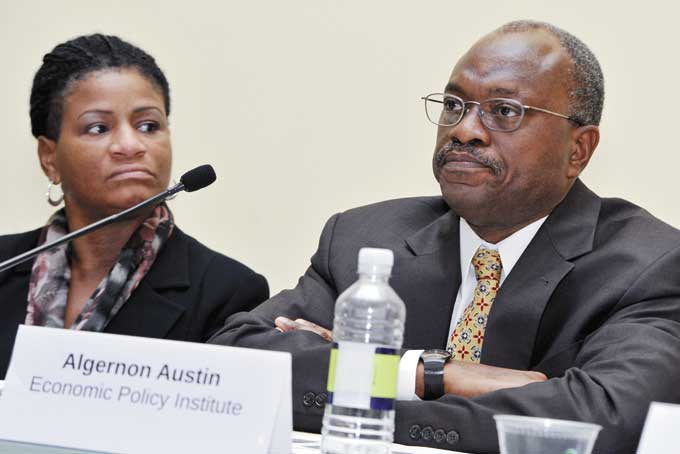
WHITE HOUSE MEETING—President Kennedy poses August 28, 1963 at the White House with a group of leaders of the March on Washington. (AP Photo)
By the end of the 1960s, the Black poverty rate was 32.2 percent. Since then, improvements in the poverty rate have slowed to a crawl, reaching its lowest mark in 2001 at 22.5 percent. According to the EPI study, the economic turmoil created by the housing crisis and the Great Recession pushed the rate up 27.6 percent in 2011, nearly triple the White poverty rate recorded that same year.
Poor Blacks often live in highly segregated neighborhoods and suffer higher exposure to environmental hazards, including lead. Black children suffer the highest exposure rates, even though lead exposure has declined for other racial groups.
“Today, nearly half of poor Black children live in neighborhoods with concentrated poverty; however, only a little more than a tenth of poor White children live in similar neighborhoods,” stated the report.
Austin said that poverty and housing issues also affect educational outcomes for the children, making it difficult to address one issue effectively while ignoring the others.
According to the report, in 2010, 74.1 percent of Black children attended predominantly Black schools.
“Part of the reason that our schools are so segregated is because our neighborhoods are also segregated,” said Austin. “The issue of segregated and unequal schools is also wrapped up in the issue of segregated and unequal housing.”
When minority student enrollment tops 90 percent at a school, the school budget takes a $443,000 hit, compared to schools where the enrolment is 90 percent or more White, according to the report. That money could go to hiring more teachers, counselors and resource staff or buying laptop computers.
Black high school students have the lowest graduation rate among racial groups at 66.1 percent. Eighty-three percent of White high school students earn diplomas.
Austin said that poverty, segregated housing, and disadvantaged unequal education all place limits on their employment and wages.
The unemployment rate for Blacks has been nearly the double the unemployment rate for Whites over the past 50 years.
“In 2012, the Black unemployment rate was 14.0 percent, 2.1 times the White unemployment rate (6.6 percent) and higher than the average national unemployment rate of 13.1 percent during the Great Depression, from 1929 to 1939,” stated the report.
Austin said that even if the goal of full employment for Black workers is achieved, it would mean little if Blacks continued to earn poverty-level wages.
The report found that 36 percent of Blacks working full-time didn’t earn enough to lift their families out of poverty.
Researchers found that 19.1 percent of low-wage Black workers in Chicago, Los Angeles and New York City were paid below the legal minimum wage and 63.9 percent were underpaid for overtime work.
“Thus, some of the lowest-paid Black workers are having their earnings effectively stolen by employers,” stated the report.
Austin said that pressing economic concerns that Black leaders identified 50 years ago, still don’t receive enough attention.
“This anniversary people should really take time to look deeply at the march, we hear King’s speech every year probably once or twice a year, but there were nine other speeches and there were seven demands,” said Austin. “We should take some time to dig a little deeper into that history and use that history to inspire us to act together.”
Austin added: “Important social change requires a mass mobilization. The Tea Party movement has managed to elect members of Congress and shape the views of some members of Congress. As a result, that movement has significant impact on our politics today.”
Clingman said that accomplishing significant economic progress in the Black community will take a movement in which Black people are willing to make individual sacrifices to achieve economic goals.
“Our economic goals are not going to come to fruition through politics alone,” said Clingman. “We’re going to have to have strong, committed, purposeful, intentional movements in order to achieve not only the goals that we have, but some of the same goals that Martin Luther King Jr., worked for before he was killed.”

OPPORUNITIES PANEL—Algernon Austin, director of the Program on Race, Ethnicity, and the Economy at the Economic Policy Institute speaks on a panel about job opportunities in the transportation industry on Capitol Hill as Michelle Holder, senior labor market analyst at the Community Service Society of New York looks on. (Freddie Allen/NNPA News Wire/File)
Follow @NewPghCourier on Twitter https://twitter.com/NewPghCourier
Like us at https://www.facebook.com/pages/New-Pittsburgh-Courier/143866755628836?ref=hl
Download our mobile app at https://www.appshopper.com/news/new-pittsburgh-courier